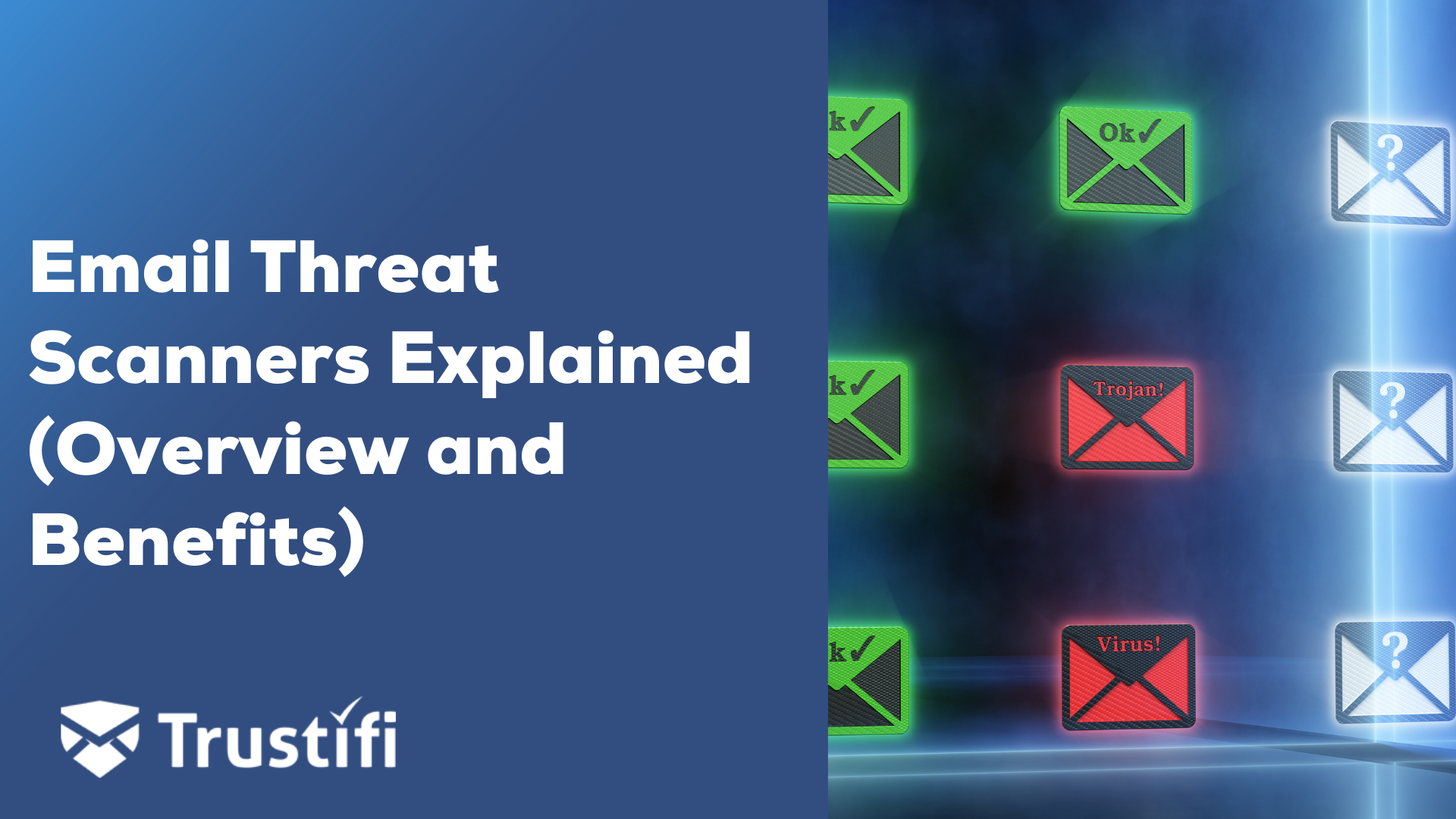Safeguarding emails from spear phishing attacks, spam emails, malware, and identity theft requires continuous innovative thinking, including updating the ability to scan, detect, and block malicious content against your email environment. Scanning emails for malicious software in 2024 requires several critical protective layers powered by artificial intelligence (AI) and machine learning (ML). Within these AI and ML engines, organizations can scan for cyber threats, including complex chain attacks, domain fraud, malware payloads, and suspicious email origins.
Trustifi, a global email security provider powered by AI and Ml, transparently enables email threat scanners embedded within their inbound shield. This market leader security capability scans every message passing through the cloud-based architecture and detects even the most complex email security threats.
Click here today to schedule a demo of this ground-breaking technology.
How Do Email Threat Scanners Work?
AI-powered email scanning goes deeper into the email message text, headers, and attachments. Trustifi’s email scanning leverages its threat intelligence services to detect better suspicious behavior spread across malicious emails simultaneously. Scanning helps organizations reduce the likelihood of malicious messages reaching user inboxes even further.

Even with advanced security awareness training and next-generation attack simulation, employees inadvertently click malicious links embedded within AI-enabled well-crafted phishing emails.
Email threat scanners, more importantly, leverage real-time deny lists, allowlists, and graymail lists. This list, combined with the various Trustifi AI engines, these tools helps detect malicious content with high confidence.

How To Use the Email Threat Scanner?
Trustifi enables the email threat scanner within their inbound and outbound shield solution. The Trustifi email scanner is an API-based solution that supports Microsoft 365 and Google Workspaces. The scanners look for several key attack indicators:

The inbound scanner focuses on three areas:
- Header analysis detects spoofing and impersonation techniques and classifies BEC/VEC/SPAM/GRAY.
- Links analysis detects malicious links and provides extensive threat analysis.
- All attachments become scanners looking for malicious content, including malware.
What are Some of the Key Features and Benefits of the Email Threat Scanner?
Stopping advanced email attacks is at the core of an email threat scanner. Here are some attacks vectored by the Trustifi email threat scanner.
DMARC – DKIM – SPF Authentication Failures – Looking for Domain Spoofing.

Phishing Attempts.

Malware Malicious Code.

Impersonation Phishing Campaign Including Whaling Attacks.

Malicious URL and Malicious Website Detection.

Data Loss Protection (DLP) Layer.

What Are the Use Cases for Email Threat Scanning?
A critical user case for organizations to leverage an email threat scanner extended the ability to identify the early stages of a kill chain. Embedded within this kill chain could be a complex series of attack vectors, including DMARC attacks, lookalike domains, user impersonation, spam, simple text-leveraged clone phishing content, a rogue QRcode, and hard-to-detect malware.
Another essential use case is the ability to detect a previously unidentified email phishing variant. The email threat scanner can detect a zero-day email phishing attack even if the variant is new. Leveraging its advanced AI, Trustifi processes email telemetry using its large language model (LLM), which is continuous learning.
How is Data Privacy and Security Maintained While Leveraging Email Scanning?
Email threat scanning is essential to stop hackers from stealing organization data user identity and propagating ransomware across their victim’s networks. Trustifi’s highly secure cloud-based platform enables its AI-powered scanners to look for malicious content within emails. Email threat scanners look for suspicious content. However, these solutions do not keep or copy the email message. Trustifi’s inbound scanning completes various analyses of the message and either blocks or passes the message to the user.
Note:The system itself does not keep a copy of the message unless the client is leveraging email archiving to help meet their compliance and regulatory needs.
Email Message Exposure Happens.
Accidental exposure happens within the email channel. Sensitive email content sent out without email encryption or MFA will often result in some form of data breach.
“Data breaches often result from negligent or accidental exposure of sensitive information rather than malicious attacks.” Because of a lack of awareness of security protocols, employees within organizations may unknowingly share, grant access to, lose, or mishandle valuable data.
Organizations leverage inbound scanning to detect threats and should enable outbound scanning. Outbound scanning aligns directly with the organization’s DLP strategy. Data Loss DLP solutions embedded within Trustifi’s consolidated management console allow organizations to scan outbound messages looking for data leakage issues, malicious content propagating to other domains, or messages impersonating the CEO as part of a outbound business email compromise attack.
FAQ
Q1: How Often Does Trustifi Update Their AI Engines?
A1: Trustifi AI continuous learning happens as more email security telemetry becomes captured with the LLM. AI data sets are created because of LLM processing. The need for a scheduled update no longer exists in AI-enabled solutions.
Q2: Should organizations enable email scanning for specific emails or scan everything?
A2: Excellent question. Yes, email attacks can occur with any message. Any email inbound to your organization should be scanned.
Q3: How important is DLP for compliance with regulations?
A3: DLP is mandatory for healthcare, financial, and government organizations.
How to Choose the Right Email Threat Scanner?
Choosing the right email threat scanner starts with a clear understanding of your current email security. Most email security providers already embed email threat scanning into their core products and solutions.
However, there are very critical differences between the various solutions. What makes one solution better than another is the experience within AI and ML capabilities deeply embedded within their solutions.
Trustifi’s maturity in AI-based email threat scanners results from its continuous innovation to add new security capabilities within its management center. These new features are accessible for their clients to enable, causing no disruption to their user base.
Trustifi’s ability to extend additional rules with a single click makes it easy for clients to manage email security operations.

Conclusion.
Why enable email threat scanning? Without this capability, next-generation phishing emails powered by adversary AI will bypass traditional anti-virus and anti-malware engines.
How Easy Is It To Enable?
Trustifi is a 100% cloud-based solution, meaning there is no need to install or update any hardware or software for email threat scanning to function. Trustifi can save organizations money on administrative tasks, bandwidth, and end-user filtering. Our technology is market-leading and easy to manage, with all user and account settings accessible from one secure online management console.
Get Started With Trustifi Today – Easy, Affordable, and Comprehensive
Whether you are looking for an extra layer of protection in your existing email environment or a full-suite solution, the expertise and simplicity Trustifi offers will exceed your expectations. Let’s discuss pricing and a customized email security plan for you.
Request a demo today!


